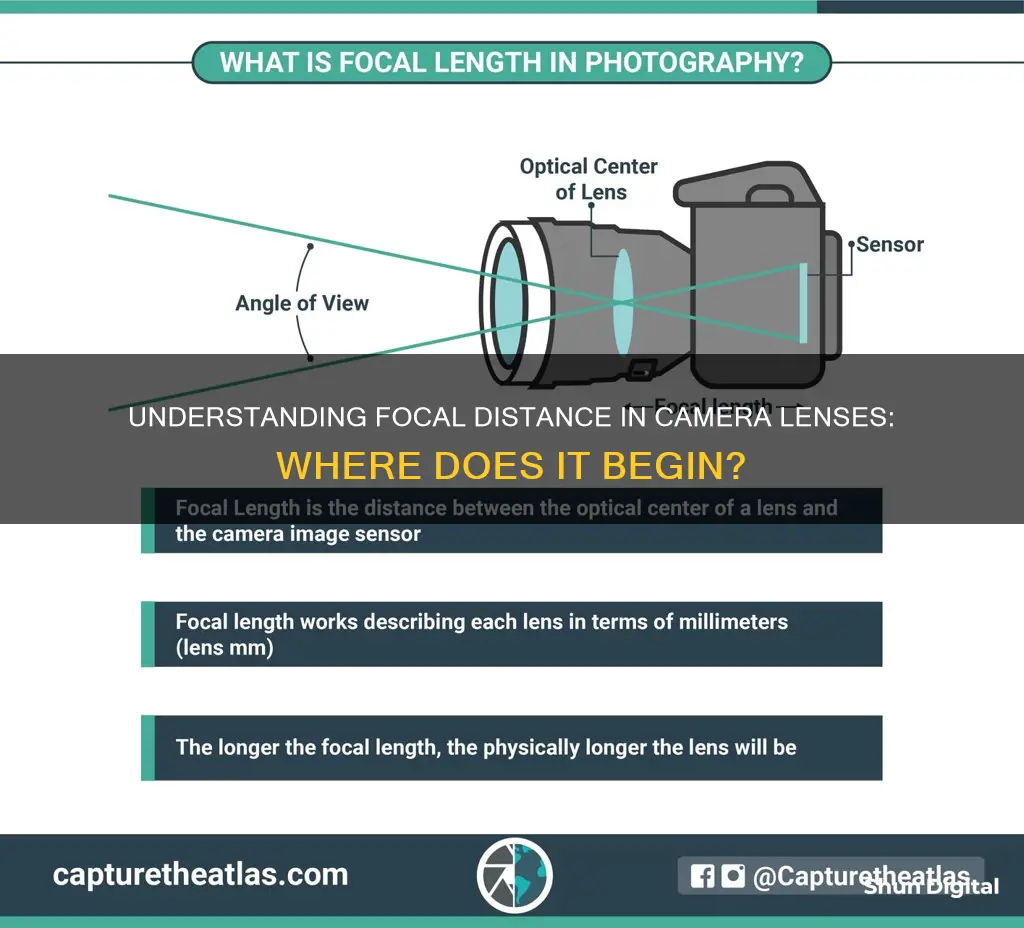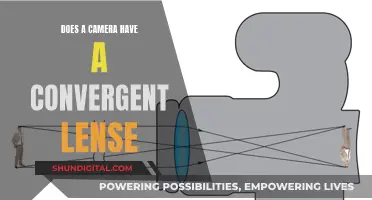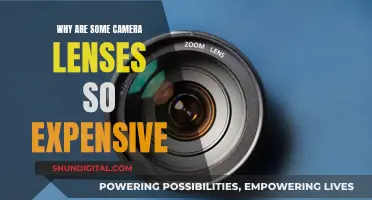
Focal length is a fundamental parameter of a lens that describes how strongly it focuses or diverges light. It is the distance, usually measured in millimetres, between the nodal or optical centre of the lens and the camera's sensor, where light converges to form a sharp image. This measurement is only possible when the lens is focused on infinity.
The focal length determines the angle of view, which is the amount of the scene that will be captured by the camera's sensor. The wider the angle of view, the more of the scene will be visible in the photograph.
Focal length is important because it relates to the field of view of a lens – that is, how much of the scene will be captured. It also determines how large or small a subject in a photo will appear.
| Characteristics | Values |
|---|---|
| Definition | The focal length of a lens is an optical property of the lens. |
| Focal Length Formula | 1/Focal length = 1/Image distance + 1/Object distance |
| Focal Length Measurement | The distance in millimetres between the "nodal point" of the lens and the camera’s sensor. |
| Focal Length and Field of View | The wider the angle of the lens, the more of the scene can be transferred to a sensor, and be visible in the photograph. |
| Focal Length and Magnification | The lens that makes objects appear small will have a small magnification, and the lens that magnifies the picture will have a big magnification. |
What You'll Learn
- Focal length is the distance between the nodal/optical centre of the lens and the camera's sensor
- Focal length is measured in millimetres
- Focal length is determined when the lens is focused on something very far away
- Focal length is an optical property of the lens
- Focal length is important because it relates to the field of view of a lens

Focal length is the distance between the nodal/optical centre of the lens and the camera's sensor
Focal length is the distance between the nodal/optical centre of the lens and the camera sensor. It is an optical property of the lens and is measured in millimetres.
The focal length of a lens determines the angle of view of the lens, which is how much of the scene will be captured by the camera. The longer the focal length, the narrower the area of the scene captured by the lens. Conversely, a shorter focal length will capture a much broader view.
The focal length is the distance from the centre of the lens to the point where light rays converge to form a sharp image on the camera sensor. This is also known as the nodal point. The focal length is only able to be determined when the lens is focused on something very far away, or focused to infinity.
The focal length of a lens is not the same as the physical length of the lens and is not determined by the overall size of the lens. It is also a property of the lens itself, not the camera. For example, a 50mm lens is a 50mm lens, regardless of whether it is attached to a full-frame camera, a cropped sensor, or a medium format camera.
The focal length of a lens is important because it determines the field of view of the lens, which is how much of the scene will be captured. It also determines how large or small the subject of the photo will appear.
What Camera Lenses Are Made Of: Metal or Myth?
You may want to see also

Focal length is measured in millimetres
Focal length is a measure of how strongly a lens converges or diverges light. It is the distance in millimetres between the nodal point of the lens and the camera's sensor. The nodal point is where light converges in a lens.
Focal length is not the same as the physical length of the lens, and it has little to do with the overall size of the lens. It is an optical property of the lens.
For a thin lens in air, the focal length is the distance from the centre of the lens to the principal foci (or focal points) of the lens. For a converging lens, the focal length is positive, and for a diverging lens, the focal length is negative.
The focal length of a lens determines the lens's field of view. The longer the focal length, the narrower the area of the scene captured by the lens. This is why a lens with a short focal length captures a much broader view than a lens with a long focal length.
Focal length is usually specified in millimetres, but some older lenses are marked in centimetres or inches.
VR Camera Lenses: Capturing the Virtual World
You may want to see also

Focal length is determined when the lens is focused on something very far away
Focal length is the distance between the plane of the sensor and the optical centre or nodal point of the lens. This nodal point is where light converges in a lens.
Focal length is important because it determines the lens's field of view and how much of a scene will be captured. The longer the focal length, the narrower the angle of view and the higher the magnification. The shorter the focal length, the wider the angle of view and the lower the magnification.
Focal length is also important because it explains how large or small a subject in your photo will appear. Higher values (like 500mm) are more "zoomed in", whereas lower values (like 20mm) are more "zoomed out".
The Ultimate Guide to Listing Camera Lenses Like a Pro
You may want to see also

Focal length is an optical property of the lens
Focal length is an optical property of a lens, and it is a fundamental parameter that describes how strongly a lens converges or diverges light. In other words, it is the distance in millimetres between the nodal or optical centre of the lens and the camera's sensor. This is also known as the rear focal length.
The focal length is determined when the lens is focused on something very far away, or focused to infinity. It is important to note that this measurement is only possible when the lens is focused on infinity.
The focal length of a lens defines its angular field of view. A shorter focal length will produce a wider angular field of view, and vice versa. This is because the focal length determines the lens's field of view, and the longer the focal length, the narrower the area of the scene captured by the lens.
The focal length of a lens also determines how much of a scene will be captured by the camera's sensor, and how large or small a subject in a photo will appear. A lens with a long focal length will bring objects closer, like a telescope, and wide-angle lenses are ideal for capturing large vistas.
The focal length of a lens is also important in determining the distance between the photographer and the subject. Objects will appear smaller in images with shorter focal lengths, and larger in those with longer focal lengths.
Focal length is one of the primary values of a photographic lens, and it is usually given in millimetres. It is important for photographers to understand focal length to create compelling images.
Understanding Camera Lenses: Capturing Unique Perspectives
You may want to see also

Focal length is important because it relates to the field of view of a lens
Focal length is important because it determines the lens's field of view. The focal length of a lens is the distance between the optical centre or nodal point of the lens and the camera's sensor. This distance is measured in millimetres and is usually displayed on the lens barrel.
The longer the focal length, the narrower the area of the scene captured by the lens. This is because a longer focal length results in a narrower angle of view. Conversely, a shorter focal length captures a much broader view. This is why a lens with a short focal length is ideal for shooting sweeping landscapes or large groups, as it can capture a wide angle of view.
Focal length also determines how large or small a subject appears in a photo. Longer focal lengths make objects appear larger, while shorter focal lengths make them appear smaller. This is why longer focal lengths are often used in wildlife photography, as they allow photographers to capture clear images of distant subjects without having to get too close.
The focal length of a lens also determines the distance between the photographer and the subject. Longer focal lengths allow photographers to maintain a greater distance from the subject, while shorter focal lengths require them to stand closer to fill the frame.
Finally, focal length affects the distance between subjects in a scene. Longer focal lengths compress the distance, making the foreground, middle, and background appear closer together. In contrast, shorter focal lengths increase the appearance of distance between planes.
Camera Lens Imperfections: Do Scratches and Marks Affect Quality?
You may want to see also
Frequently asked questions
Focal length is the distance in millimetres between the nodal or optical centre of the lens and the camera's sensor. It is an optical property of the lens and is not the same as the physical length of the lens.
Focal length determines the field of view of a lens, or how much of the scene will be captured. A longer focal length will result in a narrower field of view, while a shorter focal length will give a wider field of view.
The typical focal length formula is:
1/Focal length = 1/Image distance + 1/Object distance
Lens focal length is based on a 35mm sensor size. Most full-frame camera sensors are equivalent to 35mm, so the lens focal length will be accurate. However, in a crop sensor camera, the sensor is smaller and will magnify the image. For example, a Canon crop sensor will effectively magnify the image by 1.6x, so a 50mm lens will be equivalent to a 160mm lens.







